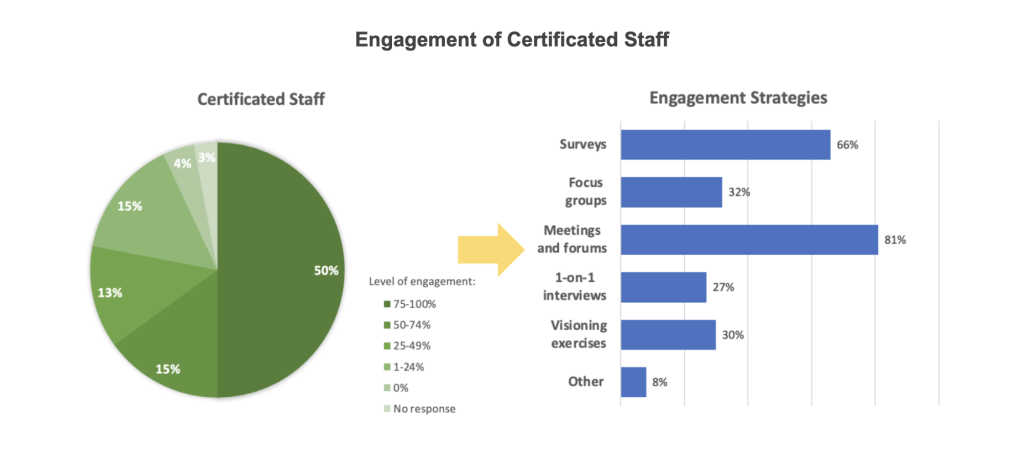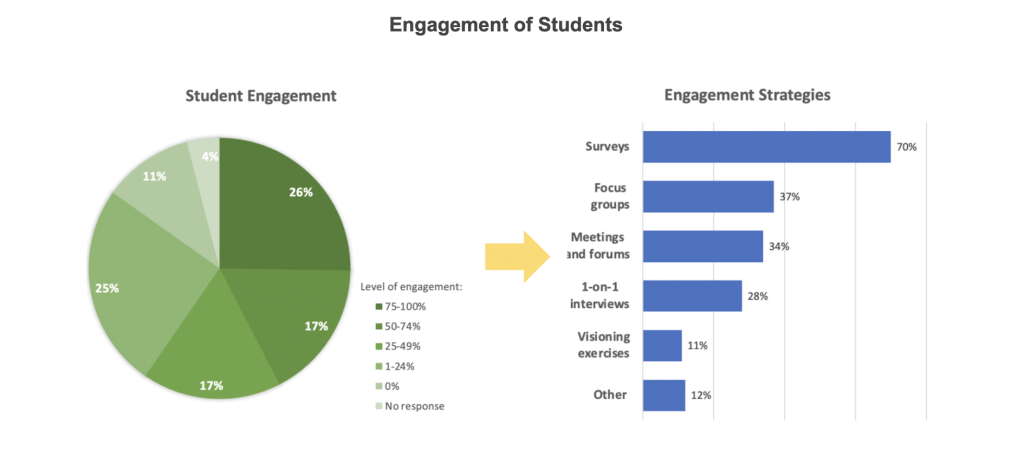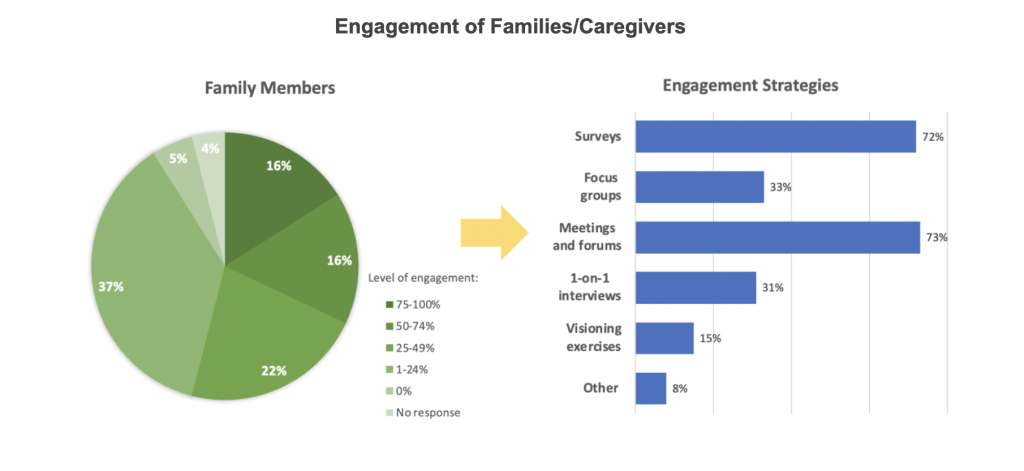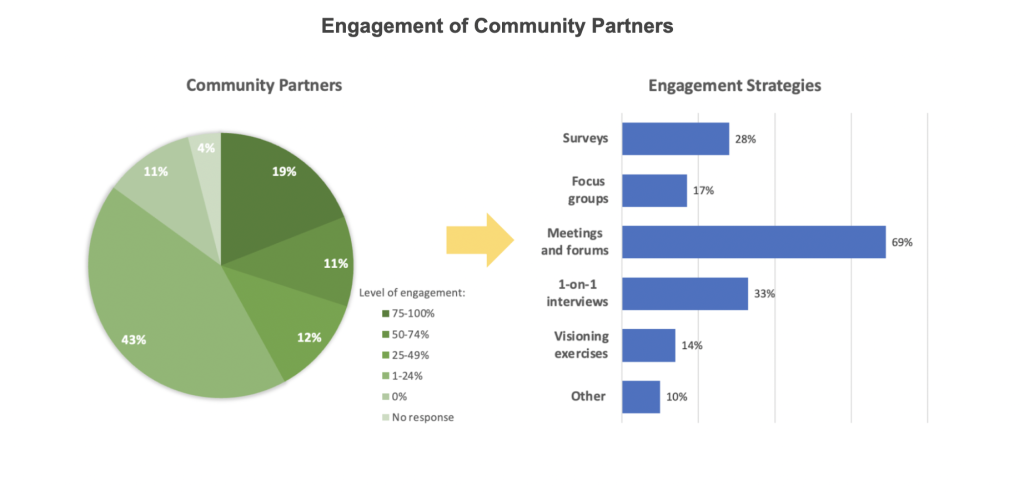Community schools unite interest-holders to collectively establish a vision—a guiding North Star—rooted in the vibrant culture, history, language, and identity of each school community and the aspirations they hold for their children and families. In our second post in the California Community Schools in Action blog series, we explore how community schools across the state are working to develop strong connections with a range of diverse interest-holders within their community—students, families/caregivers, staff, community members, and partners—to actively engage them in the development and implementation of a shared vision of their community schools strategy.
Decades of research and experience emphasize the positive impact associated with ongoing, authentic public engagement in schools. Meaningful engagement nurtures relationships based on trust and respect, bolstering the capacity of all interest-holders to participate in shared decision-making processes and to identify collective priorities that respond to local strengths and needs. This lays the foundation for implementing programs and services in a collaborative manner. Further, schools that authentically engage students, families/caregivers, staff and communities gain a deeper understanding of the rich assets, expertise, and funds of knowledge present within their community. This understanding can be leveraged to address identified priorities, inform powerful teaching and learning strategies, and cultivate positive student outcomes.
As part of the Annual Progress Report (APR) process, California Community School Partnership Program (CCSPP) grantees were asked to reflect on the extent to which they engaged interest-holders in identifying their community school priorities and setting a shared vision. Grantees also reflected upon the processes they used to engage interest-holders in developing their community school priorities: surveys, focus groups, one-on-one interviews, visioning exercises, and meetings/forums. In this blog post, we explore the community engagement practices adopted by the 450 schools who formed part of the first cohort of CCSPP implementation grantees (read more about CCSPP and CCSPP grantees in our first blog post).
Community schools aim to engage the entire school community in establishing and working towards meeting their North Star. Yet, achieving this goal takes time. In Year One of CCSPP implementation, we found that schools were experimenting with a range of strategies aimed to deepen engagement. Administrators, certificated staff like teachers, and classified staff were most engaged in identifying school priorities and setting its vision. We also found that grantees sought support to strengthen and bolster the engagement of students, family members/caregivers, community partners and members in shaping priorities, and defining and implementing their school’s vision.
Engaging Administrators and Staff in Building Community Schools
School administrators, certificated staff such as teachers, and classified staff, play a pivotal role in the success of their community schools. As individuals closely connected with students, families, and the community, their engagement in shaping community school priorities is essential. They also play an important role in developing shared leadership structures and welcoming spaces that invite others to participate in collective decision-making. APR data highlights the high level of staff engagement in developing their community school. Over 80% of schools reported that administrators were engaged at high levels. These schools estimated that at least half of administrators were engaged in developing priorities. Among classified staff, such as instructional aides, 51% of schools reported that they were engaged at high levels (50% or above). As shown in the figure below, 65% percent of schools reported engaging at least half of teachers and other certificated staff.
Meetings and forums were the most common method of engagement among all three interest-holder groups, followed by the use of surveys. As shown above, approximately a third of schools also utilized one-on-one interviews and visioning exercises to engage their certificated staff members. One CCSPP grantee shared that in addition to monthly meetings as a community school site team, they hold “biweekly meetings with a core community school team comprising administrators, coordinators, teacher leads, [family and community liaisons], and Title I representatives…” The grantee shared how these standing meetings and frequent check-ins “further facilitate communication and collaboration…” that are critical in identifying priorities.
Engaging Students in Building Community Schools
At the heart of every community school are its students. Their voices, perspectives, and contributions are essential in building a community that supports their learning, healthy development and future success. In Year One of implementation, 42% of grantees reported engaging at least half of their students in identifying collective priorities. Eleven percent of grantees shared that they had yet to engage their students in the development process, highlighting student engagement as an area of growth for many schools. Although grantees have embraced a variety of strategies to engage students in the process, surveys were most commonly used, with 70% of schools indicating their use. Approximately one-third of grantees used more involved strategies such as focus groups (37%) or meetings/school forums (34%).
As shared in our first post, CCSPP school grants were awarded to schools that serve a high concentration of students with the greatest needs. Ninety percent of students who are enrolled in schools that received implementation grants in Cohort 1 are either low-income, English learners, or foster youth (compared to a statewide average of 63% for these populations), aligning with the state’s goal of prioritizing schools that serve students with the highest level of need. Implementation grants also appear to be benefitting a disproportionately large share of African American (8%) and Latino/a/x students (74%) as compared to statewide averages for both groups. To ensure the engagement of students who have been historically marginalized, grantees were asked to reflect on effective practices. Schools shared a range of practices. According to the APR response of one grantee: “Our school engaged in a yearlong process of visioning around school and community culture, and learned about the diverse student experiences in our school community through student focus groups, day-in-the-life of a student, student surveys, student empathy interviews, family empathy interviews, stakeholder interviews, etc. This landed [us] on this year’s priority work and learning around a sense of belonging, wraparound support, strong relationships between individuals across the community and beyond, and shared ownership and responsibility for our community …” Another grantee shared how students’ firsthand experiences and insights provided invaluable perspectives that were actively integrated into the planning and implementation of their initiative: “[We] conducted equity focus groups … all of the themes gathered were synthesized for root causes and brought back to all groups in a continuous cycle of improvement and refinement of the community school improvement plans …” Few responses, however, addressed strategies that targeted particular populations, indicating an area of need for CCSPP grantees as they aim to improve their efforts to engage our most vulnerable young people and their families.
Engaging Families in Building Community Schools
Family/caregiver engagement strengthens the partnership between schools and their surrounding communities and centers the assets, needs and aspirations of families in the work of community schools. According to APR data, 32% of CCSPP grantees reported engaging over half of their families in developing community schools, signaling opportunity for growth and improvement. In Year One, the most common engagement strategies included meetings/forums and surveys, with a significant portion of schools also utilizing more intensive approaches such as focus groups and interviews to gather family/caregiver perspectives on the community school process.
Through the APR, schools provided examples of a number of strategies that were focused on sharing information such as monthly parent newsletters and events aimed to learn from families and caregivers like “Back-to-School Nights” and principal chats. One CCSPP grantee shared, “… through regular parent-teacher conferences, family workshops, and community events, the school strengthens its ties with surrounding neighborhoods.” Strategies shared made evident that grantees are working to authentically strengthen relationships to create opportunities to meaningfully engage families/caregivers in developing the work of community schools.
Engaging Community Members/Partners in Building Community Schools
Fully engaging community members and partners in developing their community school proved challenging for grantees. As shown below, 30% of school-level CCSPP grantees indicated that they have engaged over one half of their community partners in developing their community schools’ vision. Community members were engaged in developing priorities at a lower rate, with 14% of schools reporting they engaged more than half of their community members. Meetings/forums were the most common strategy used by schools to engage both members and partners.
Some grantees shared that they have strengthened their partnerships with an array of community partners, including healthcare providers, after-school programmers, etcetera, with the goal of enriching students’ educational experiences and responding to students’ and families’ holistic assets and needs. Few grantees, however, discussed strategies of engagement that highlighted how partners are shaping their community schools strategy. Similarly, grantees recognized the importance of involving the broader community in these efforts. While several grantees shared how they worked alongside community members to address issues such as safety, limited play space, lack of community resources, APR data shows that CCSPP grantees can improve their efforts to dream collectively with the community and work together to foster thriving students, families and communities.
What’s next?
Community schools remind us that transformation is a collective journey. Together, administrators, staff, students, families/caregivers, community partners and members, are establishing an aspirational vision that is grounded in the rich culture, history and identity of each school community. In this second post, we explored how CCSPP grantees are deepening relationships with interest-holders to meaningfully engage them in this collective work. We found, based on APR data, that a majority of grantees are engaging more than half of their school-level personnel (administrators and staff) in developing their community school vision and identifying priorities. APR findings also show that grantees can improve and expand their strategies to engage students, families and the community. Indeed, when asked about their needs for additional support and assistance, 64% of grantees identified family and community engagement as an area in need of strengthening.
These data remind us that CCSPP is still in the initial stages of implementation. Grantees are working to build relationships and are developing new, effective, and equitable engagement strategies that CCSPP requires. In addition to establishing a collective vision, community engagement sets the groundwork for an effective needs and assets assessment process that guides implementation, and for establishing shared leadership structures. As such, community schools must go deeper and broader in their engagement efforts—going beyond understanding and identifying the needs of interest-holders, to establishing ways to meaningfully work together to achieve their North Star.
Stay tuned for more information on how schools and districts participating in the historic California Community Schools Partnership Program are transforming the educational landscape. In subsequent posts, we’ll explore grantees’ reflections on shared leadership practices, implementation strategies, and grantees’ progress toward identified goals.





